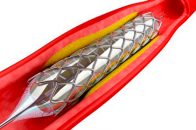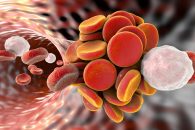Courtesy of SBHCI. According to a new quality of life sub-study, the “EXCEL”, both coronary artery bypass graft and left main PCI are associated with significant clinical improvement in terms of angina frequency, tolerance to exertion and treatment satisfaction. At 12 and 36 months, there were no significant differences between PCI and surgery after several quality of…
Fentanyl in Angioplasty: What Is the Price of More Comfort During the Procedure?
Fentanyl is a potent opiate commonly administered in the cath lab. Recently, questions on its safety have been raised by research demonstrating that intravenous morphine significantly delays the absorption of oral P2Y12 platelet inhibitors. The mechanism might be slowed gastric emptying. The Platelet Aggregation with tiCagrelor Inhibition and FentanYl (PACIFY) trial enrolled 212 patients undergoing indicated…
2.0-mm DES for Very Small Vessels: Are They Viable?
The reference vessel diameter is a fundamental factor for restenosis after coronary angioplasty even with drug-eluting stents. The smallest sized stents available are 2.25 mm in diameter, but even smaller vessels can be symptomatic. This was a prospective multicenter trial of the Resolute Onyx 2.0-mm zotarolimus-eluting stent. The primary endpoint was target lesion failure. Read also: “Effects…
With Absorb Out, New Resorbable Scaffolds Have Come onto the Market
By restoring vascular physiology and eliminating the inflammatory focus and the chance of fracture and neo atherosclerosis inherent to DES, bioresorbable scaffolds offer the potential to improve long term outcomes. A number of bioresorbable materials have been tested, mainly polylactic acid, with several limitations that have taken the Absorb bioresorbable scaffold out of the market.…
Diabetics’ Silent Ischemia Myth Busted
Diabetes mellitus patients generally present more diffuse coronary disease, faster lesion progression and higher risk of restenosis after PCI. The way these anatomical differences translate into in a different clinical practice, compared to non-diabetic patients, remains unclear. Prior studies comparing the frequency of angina symptoms in diabetic vs. non-diabetic patients have arrived to contradicting outcomes,…
Is Same-Day Discharge After Angioplasty Safe?
Overnight observation after coronary angioplasty has been the standard of care in the United States. The foundations for this practice go back to the early days of balloon angioplasty, when acute occlusion and access-site complications were frequent. There are several registries and randomized studies showing the clear safety of same-day discharge after coronary angioplasty. This practice…
“Ad Hoc” PCI during TAVR: No Impact on Safety or Long Term Outcomes
According to a recent study published in Circulation Cardiovascular Interventions, screening for coronary artery disease (CAD) with an invasive coronary angiography (as part of the protocol prior TAVR) and performing PCI and TAVR in the same session, has no impact on periprocedural safety or on long term outcomes. Study outcomes offer new hope, especially as regards using TAVR…
Dual antiplatelet therapy discontinuation causes more thrombotic events at 12 months
Several randomized studies have shown that dual antiplatelet therapy (DAPT) is as effective to prevent thrombotic events in the segment treated with PCI, as it is with the rest of the coronary segments. This is very clear. The problem is there are a series of adverse events following P2Y12 inhibitor discontinuation. This phenomenon called rebound effect, happens…
Risk of Thrombosis and Bleeding with Peripheral Artery Disease and Concomitants
Peripheral artery disease (PAD) is no longer a systemic manifestation of atherosclerosis. In fact, 2 in 3 people with PAD have concomitant heart disease, and 1 in 3 people has concomitant PAD. To understand the real dimension of this problem, we should know that PAD patients have 60% more risk of acute myocardial infarction…
Clinical Significance of Collaterals in Chronic Total Occlusions
Collateral circulation develops during the gradual progression of coronary occlusions in order to replace the original artery and supply blood to areas jeopardized by ischemia. However, the relevance of collaterals has remained controversial for many years. Several works have suggested a rapid regression of collaterals after rechanneling of chronic total coronary occlusions, which could render…









